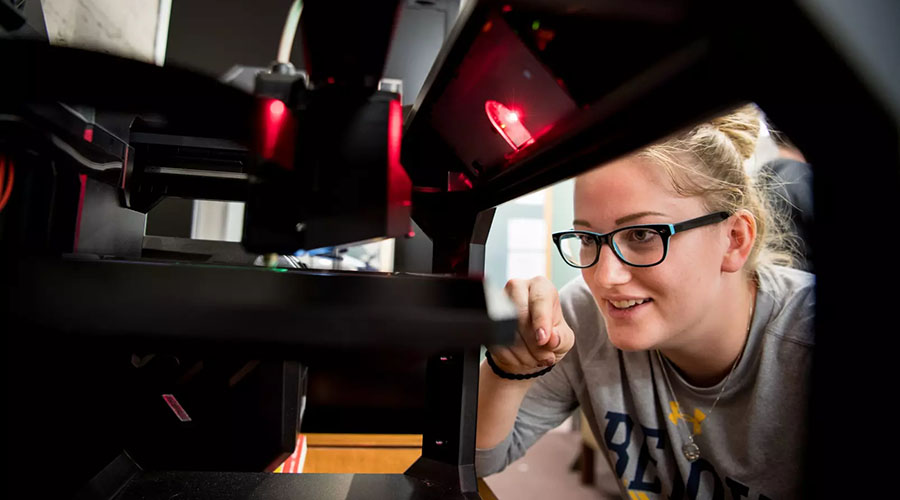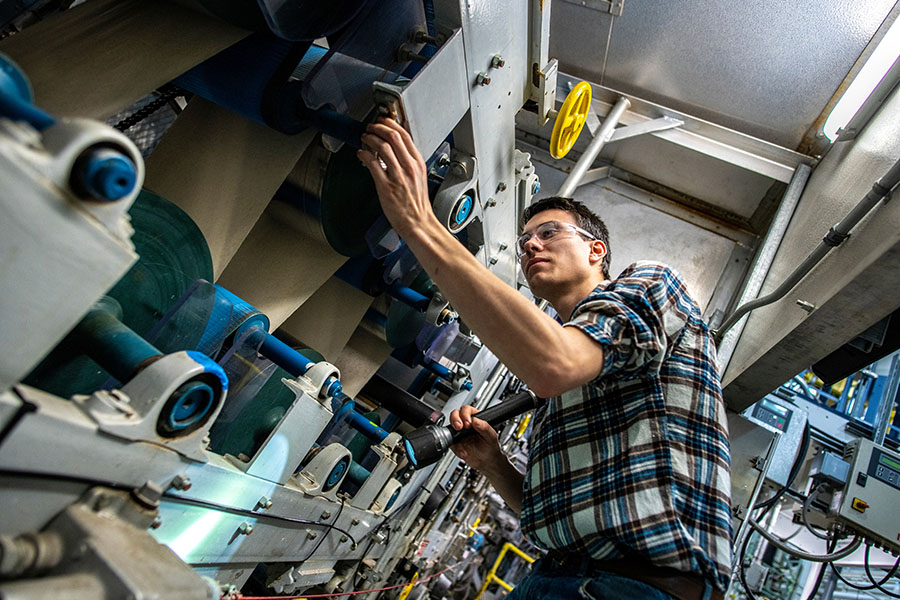
July/August 2023 (Volume 32, Number 7)
To Bolster Undergraduate Enrollment, Some Colleges Are Emphasizing Engineering Physics Degrees
Beloit College in Wisconsin and the University of Maine model different approaches to engineering physics.
By Liz Boatman | June 15, 2023

Credit: Howard Korn / Beloit College
A Beloit student works with a 3D printer at the college’s makerspace. Beloit’s new engineering physics program has relied in part on existing campus resources, like the makerspace.
Across the United States, enrollment in undergraduate physics programs has been sliding, but engineering — which traditionally pulls from similar student demographic groups — has fared better. Some schools, like Beloit College in southern Wisconsin, are taking the hint.
At Beloit, the physics department saw a new engineering physics major as an opportunity to attract two to three new students per year, says physics chair Britt Scharringhausen. “Like any college, we’re dealing with changing student demographics, and students coming in with different kinds of interests.”
While engineering programs are typically taught out of dedicated engineering departments and colleges, engineering physics programs are most commonly housed in physics departments. In general, they offer a similarly strong curriculum in the fundamentals, but with deeper theory content and a more scientific approach.
When Beloit’s physics department was first mulling over the idea of developing an engineering physics program, the department’s longstanding “3-2” dual-degree engineering program — where students spend three years at Beloit and two years at a partner engineering school, eventually earning two degrees — was growing in popularity, although it wasn’t ideal for everyone, Scharringhausen says.
“So the thought was, could we make Beloit even more attractive to students who have an engineering interest, if there’s an option where they can stay here the whole four years?” she says. Athletes could play for Beloit longer; students could avoid the extra year of tuition.
The key was finding a way to introduce engineering-specific courses to support the new major, while keeping upfront costs low — and that meant making use of existing resources and not bringing in new faculty. With a makerspace on campus, the college had already invested in several design and build capabilities, like CAD software and 3D printers, says Scharringhausen.
For the physics faculty, the hardest part was managing the added teaching load. To meet the challenge, the program coupled half-size engineering courses with existing physics courses, says Scharringhausen. “We pair classical mechanics with a statics course, and we pair electricity and magnetism with an advanced circuits course.” In the engineering add-on courses, students do a hands-on design and build project.
The department also lets physics majors use engineering courses to fulfill in-major electives, which helps boost enrollment in the new courses and balance out teaching loads for the department’s three faculty. Using this approach, Scharringhausen said the department didn’t have to make much of an appeal to Beloit’s administration.
The engineering physics major rolled out two years ago. So far, so good, she says: While enrollment is down college-wide, the numbers in physics have held steady. “We’ve been getting a lot of interest,” says Scharringhausen. “I think students like the idea of having another option.”
At the University of Maine, engineering physics is also a popular choice in the department of physics and astronomy, says recent department chair John Thompson. Launched in 1938, UMaine’s engineering physics program was one of the first in the country.
“Engineering physics is a very versatile degree,” says Thompson.
Unlike Beloit, the University of Maine also has engineering programs, housed in a separate college. UMaine’s engineering physics students take a set of physics courses with physics majors, and then they select an engineering concentration — a partially prescribed set of courses taken through the engineering college.

Credit: University of Maine
Unlike Beloit College, the University of Maine’s engineering physics program has ABET accreditation and collaborates with the school’s separate engineering college.
Thompson says that collaborating with engineering faculty has been good for the department. “Because we teach the introductory physics courses that are gateway courses for the engineering students, we have a good relationship with the engineering college,” he says.
And even though some would-be engineering students might ultimately choose engineering physics, Thompson says the numbers are small, so there hasn’t been “tension” with the engineering college.
UMaine’s engineering physics program has ABET accreditation, a necessity for their graduates to be considered true ‘engineers,’ professionally speaking.
Thompson says that maintaining ABET accreditation for the engineering physics program “gives us some guidelines for what we [the faculty] need to be doing,” he says. “The accreditation process is there to make sure that your program is continuously improving, that you’re paying attention to what students want and what the engineering profession needs.”
But not all engineering physics programs are designed to yield ‘engineers,’ so not all schools pursue ABET accreditation, which can be costly and time-consuming. Beloit, like many other small schools, has no intention of pursuing ABET accreditation for its new engineering physics program, says Scharringhausen.
Plus, Thompson adds, prospective students who come to UMaine for its engineering physics program don’t necessarily choose it because it’s accredited. “I think they’re just excited about what our programs offer,” says Thompson. So, while accreditation bolsters their program, he doesn’t think it’s a must-have for all new programs.
And both schools have looked beyond engineering physics to improve department culture. Several years ago, as growing numbers of first-generation college students were enrolling in UMaine’s physics department, the faculty felt compelled to adapt. “That’s one of the things that the university overall and our department is trying to pay attention to — how to get these students acclimated to college life,” Thompson says.
To make its early curriculum shine, the department studied other schools for inspiration. Following the University of Colorado’s lead, and starting with support from an NSF Math-Science Partnership award, the physics and astronomy department now uses undergraduate ‘learning assistants’ in two introductory and three sophomore-level courses. In lectures, they “go up and down the aisles and help students think about the questions, help guide them,” says Thompson. “The students also learn that [the learning assistants] are people they can go to for help outside of class. And I think it builds community in the department.”
Still, the pandemic impacted both student retention and enrollment, especially in the physics and engineering majors, says Thompson. And last year, the state made community college free for everyone. These factors have lowered the size of recent incoming classes, he says.
Thompson is hopeful that, in a few years, as students begin to move through the community college programs, enrollment will climb back up — from about 70 undergraduates now to roughly 100, where it used to be.
At Beloit, Scharringhausen is seeking to build stronger ties with local industry partners, to help students see more connections between the department’s programs and eventual careers. She hopes this will help keep the department’s program numbers strong, even in the face of the ‘enrollment cliff’ projected to hit colleges in 2025.
“My philosophy is, the world needs all different kinds of engineers,” says Scharringhausen. “We need engineers that have had different educational paths, because then they bring to a company or a project different skills and strengths and knowledge.”
Liz Boatman is a staff writer for APS News.
To future-proof your physics department, visit the APS Effective Practices for Physics Programs (EP3) guide.
Read more:
As Undergrad Physics Enrollment Stumbles, Departments Look Inward (APS News, June 2023)
Newest Data Shows Mixed Progress for Women and Marginalized Groups in Physics Higher Ed (APS News, November 2022)
Navigating the EP3 Guide to Enact Change (APS News, April 2022)
Effective Practices for Physics Programs Guide Makes its Debut (APS News, February 2021)
Engineering and Physical Science Degrees Earned by Members of Underrepresented Groups (AIP)
©1995 - 2024, AMERICAN PHYSICAL SOCIETY
APS encourages the redistribution of the materials included in this newspaper provided that attribution to the source is noted and the materials are not truncated or changed.
Editor: Taryn MacKinney
July/August 2023 (Volume 32, Number 7)
Articles in this Issue
